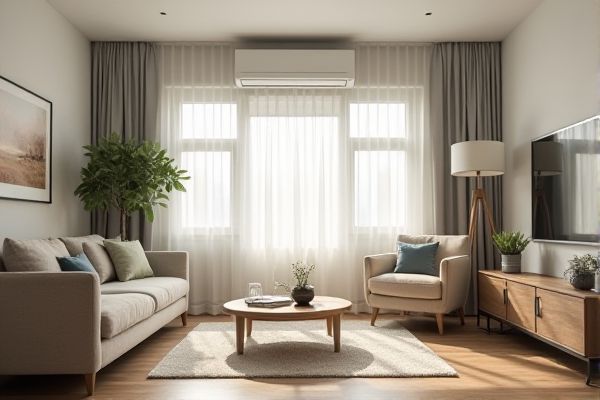
Mini split AC systems offer efficient, quiet cooling with permanent installation and zoned temperature control, ideal for consistent climate management in specific areas. Portable AC units provide flexible, easy-to-move cooling solutions without installation, perfect for temporary use or rental spaces; explore the rest of the article to determine which option best suits Your cooling needs.
Table of Comparison
| Feature | Mini Split AC | Portable AC |
|---|---|---|
| Installation | Requires professional installation, wall-mounted | Easy DIY setup, freestanding unit |
| Cooling Capacity | High efficiency, suitable for entire rooms | Moderate, ideal for small spaces |
| Energy Efficiency | Energy Star rated, lower power consumption | Less efficient, higher electricity usage |
| Noise Level | Quiet operation, compressor outside | Relatively noisy, internal compressor |
| Mobility | Fixed installation, not portable | Portable, can be moved between rooms |
| Maintenance | Periodic professional servicing needed | User-friendly, easy to clean filters |
| Cost | Higher upfront cost, long-term savings | Lower initial cost, potentially higher operating cost |
Introduction to Mini Split AC and Portable AC
Mini split AC systems offer efficient cooling with separate indoor and outdoor units, providing targeted temperature control for individual rooms and energy savings. Portable AC units are compact and easy to move, making them ideal for temporary or small space cooling without permanent installation. Your choice depends on whether you need a flexible, mobile solution or a more permanent, energy-efficient cooling system.
How Mini Split AC Works
Mini split AC systems operate using an outdoor compressor and an indoor air-handling unit connected by refrigerant lines, enabling efficient cooling without ductwork. The refrigerant absorbs heat from inside your space and releases it outdoors, providing targeted temperature control with minimal energy loss. This design offers quieter operation and better cooling efficiency compared to portable AC units, which rely on exhaust hoses and often lose cool air through window vents.
How Portable AC Functions
Portable AC units function by drawing warm air from the room, passing it over refrigerant-filled coils to cool it, and then expelling the cooled air back into the space while venting hot air through an exhaust hose. Unlike mini split AC systems, which have separate indoor and outdoor units connected by refrigerant lines, portable ACs are self-contained and offer easy mobility without permanent installation. Your choice depends on the need for flexibility and the size of the area being cooled.
Installation Comparison: Mini Split vs Portable AC
Mini split AC units require professional installation involving mounting an outdoor compressor and indoor air handler, ensuring permanent, energy-efficient cooling with concealed piping and electrical work. Portable AC units offer plug-and-play convenience with no permanent installation, relying on venting a flexible exhaust hose through a window or wall opening. While mini splits provide quieter operation and better climate control, portable ACs provide mobility and ease of setup, ideal for renters or temporary cooling needs.
Cooling Efficiency and Performance
Mini split AC units offer higher cooling efficiency due to their direct refrigerant lines and inverter technology, which adjusts compressor speed to maintain consistent temperatures. Portable ACs typically have lower performance because they rely on ductless ventilation and often expel heat back into the room through exhaust hoses. Your best choice depends on the size of the space and the need for energy savings or mobility.
Energy Consumption and Cost Analysis
Mini split AC systems generally consume less energy than portable AC units due to their efficient inverter technology and direct cooling mechanisms, making them more cost-effective for long-term use. Portable ACs typically have higher energy consumption rates as they often rely on less efficient single-stage compressors and must cool a broader area, increasing utility bills over time. Although mini splits involve higher initial installation costs, their superior energy efficiency results in lower operational expenses compared to the more affordable but less energy-efficient portable air conditioners.
Space and Design Considerations
Mini split AC systems offer a sleek, wall-mounted design that saves floor space and complements modern interiors, making them ideal for rooms where space optimization is crucial. Portable AC units require no permanent installation but occupy significant floor area and may disrupt room aesthetics due to bulky appearance and exhaust hose placement. Mini splits provide quieter operation and better temperature control, whereas portable ACs offer flexibility to move between rooms at the cost of increased noise and space usage.
Maintenance and Longevity
Mini split AC systems typically require less frequent maintenance than portable AC units due to their sealed components and durable installation. Regular cleaning of filters and professional servicing can extend a mini split's longevity beyond 10 years, whereas portable ACs often need more frequent filter replacements and have a shorter lifespan of around 5 to 8 years. Your choice impacts long-term upkeep costs, with mini splits offering greater durability and less maintenance effort over time.
Noise Levels and Comfort
Mini split AC units typically operate at lower noise levels ranging from 19 to 40 decibels, creating a quieter and more comfortable indoor environment compared to portable ACs, which often produce noise levels between 50 and 60 decibels. The enhanced comfort of mini splits stems from their efficient airflow distribution and consistent temperature control without the need for bulky hoses or frequent repositioning. Portable ACs may cause uneven cooling and increased noise due to internal fans and exhaust vents, making mini split systems a preferred choice for noise-sensitive and comfort-focused users.
Choosing the Right AC for Your Needs
Mini split AC systems offer energy-efficient cooling tailored for specific rooms, featuring quiet operation and easy temperature control. Portable AC units provide flexible, temporary cooling solutions that require no installation but are generally less efficient and noisier. Consider your space size, installation preferences, and cooling requirements to determine which option best meets your comfort needs.
 homyna.com
homyna.com